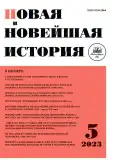Stalin's “Soft Power”: Activities of the Commissioner for Foreign Military Formations in the USSR During the Great Patriotic War
- Authors: Bezugolny A.Y.1
-
Affiliations:
- Institute of World History, RAS
- Issue: No 5 (2023)
- Pages: 124-143
- Section: 20th century
- URL: https://journals.rcsi.science/0130-3864/article/view/251128
- DOI: https://doi.org/10.31857/S013038640025683-9
- ID: 251128
Cite item
Full Text
Abstract
About the authors
Alexey Yur'evich Bezugolny
Institute of World History, RAS
ORCID iD: 0000-0002-4055-0563
Russian Federation, Moscow
References
- Андерс В. Без последней главы. Польская армия в СССР // Звезда. 2013. № 1. С. 157–200; № 2. С. 110–136.
- Военнопленные в СССР. 1939–1956: документы и материалы. М., 2000
- Государственный Комитет Обороны СССР. Постановления и деятельность. 1941–1945 гг. Аннотированный каталог: в 2-х т. М., 2015.
- Джилас М. Разговоры со Сталиным. Франкфурт-на-Майне, 1970.
- Зданович А.А. «Польская воинская часть… высоко поднимет вес и авторитет поляков в ходе войны и в становлении послевоенной Европы». Рождение Войска польского (1942–1944 гг.) // Военно-исторический журнал. 2011. № 2. С. 48–54.
- Зданович А.А. Роль НКВД в формировании польской армии В. Андерса (1941–1942 гг.) // Военно-исторический журнал. 2010. № 9. С. 53–60.
- Из Варшавы. Москва, товарищу Берия… Документы НКВД СССР о польском подполье. 1944–1945 гг. М.; Новосибирск, 2001.
- Катынь. Март 1940 г. – сентябрь 2000 г. Расстрел. Судьбы живых. Эхо Катыни. Документы. М., 2001.
- Катынь. Пленники необъявленной войны. Документы и материалы. М., 1997.
- Куманев Г.А. Рядом со Сталиным. Смоленск, 2001.
- Марьина В.В. Чехословацкие воинские части в СССР. 1941–1945 гг. // Новая и новейшая история. 2010. № 3. С. 83–106
- Микоян А.И. Так было. Размышления о минувшем. М., 1999.
- Носкова А.Ф. Генерал З. Берлинг: штрихи к политическому портрету // Профессор Московского университета И.М. Белявская: (к 90-летию со дня рождения). М., 2005. С. 263–279.
- Петров Н.В. Кто руководил органами госбезопасности. 1941–1954: справочник. М., 2010.
- Русский архив. Великая Отечественная. Т. 14 (3–1). СССР и Польша: 1941–1945. К истории военного союза. Документы и материалы. М., 1994
- Русский архив. Великая Отечественная. Т. 14 (3–2). Красная Армия в странах Центральной, Северной Европы и на Балканах, 1944–1945. Документы и материалы. М., 2000.
- Русский архив. Великая Отечественная. Т. 16 (5–4). Ставка ВГК. 1944– 1945 гг. Документы и материалы. М., 1999.
- Русский архив. Великая Отечественная. Т. 23 (12–4). Генеральный штаб в годы Великой Отечественной войны: документы и материалы, 1944–1945 гг. Документы и материалы. М., 2001.
- Советский Союз и Словацкое национальное восстание / пред. В.В. Марьиной // Новая и новейшая история. 1996. № 5. С. 101–131.
- Советский фактор в Восточной Европе. 1944–1953 гг.: в 2-х т. Документы. Т. 1. 1944–1948 гг. М., 1999.
- Сорокин А.К. «Практический работник» Георгий Маленков. М., 2021.
- Филиппов В., Ларин Г. Против общего врага. Советские воины в Войске польском. 1943–1968. Рязань, 2021.
- Шинкарев И.И. Роль Советского Союза в создании вооруженных сил стран Восточной и Юго-Восточной Европы в годы Великой Отечественной войны: дис. … канд. ист. наук. М., 1966.
- Stańczyk H., Zwoliński S. Wojsko Berlinga i Żymierskiego 1943–1945. Warszawa, 2015.
- Wojsko Polskie w ZSRR w 1943 roku wobec powstającego systemu władzy: udział 1. Dywizji piechoty im. Tadeusza Kościuszki w bitwie pod Lenino. Warszawa, 2003.
Supplementary files










